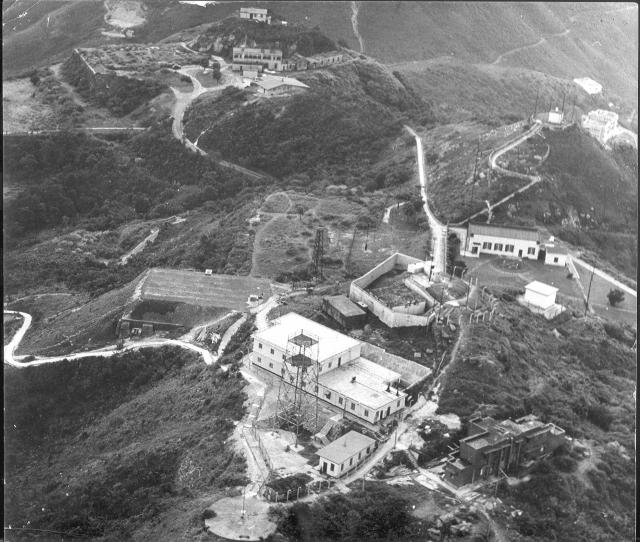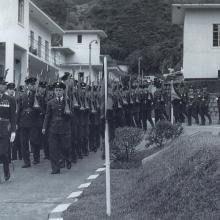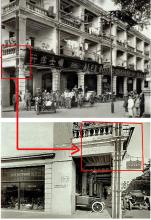This photograph was given to me by the late Flt. Lt. Ken Sly, Officer Commanding the unit at Battys. In order to keep up his flying hours and the associated pay, Ken had to fly 10 hours each month, usually with other arcrew who were desk bound, ut who also wanted to retain their flying pay, as passengers. So, one day each week he flew, sometimes with Flt Lt. Ted Canton as his wing man, around the colony. Ken told me that, at that time R.A.F. Kai Tak only had two planes, a Harvard and a Meteor, on which Ken was qualified to instruct. He also had access to the small fleet of Auster planes of the Hong Kong Auxiliary Air Force. On this occasion he had taken his Senior N.C.O., Flight Sergeant, later Warrant Officer Franki Curzon up, and Frank was a very good photographer. Ken started his career in the R.A.A.F. and R.A.F during World War II as an operational Lancaster pilot. The photograph is unique as it shows the main features on the summit of the Peak. A very derelict area of ground in the top left corner is where the Governor's summer residence and garden used to be. The conical hill at top right is the site of the orginal Battys Belvedere. That and the zig zag path up it features on several Victorian postcards of the Blevedere, and the path is, I believe, still visible on Google Earth. The derelict brick house in the right bottom corner is the one that was reputed to be haunted. The two storey R.A.F building stands at lower centre and the circular platform where the Victorian signal mast used to stand is below it. The Victorian building associated with the original signal station is at the other side of the platform. Its curved roof is clearly visible. That building also features on several Victorian postcards. For many years I had 'remembered' that the old signal canon had been on the circular concrete platform but, as you will see below, that was a false memory, as it was on the grass fairly close to the derelict brick building. (Andrew S)
R.A.F. Batty's 1958
Primary tabs

Submitted by Andrew Suddaby
Date picture taken (may be approximate):
Wednesday, January 1, 1958
Gallery:
Connections:
- R.A.F. Batty's 1958 shows Place RAF Batty's Belvedere [????-????]
- R.A.F. Batty's 1958 shows Place Peak Signal Station - Flagstaff [1860- ]



Comments
Great Photo
Thank you for posting. A good write-up. IWM has an audio here (Reel 3) of a linguist/interpreter and his impressions of Hong Kong and work at Batty's.
Lots to see!
Hi Andrew,
Thanks for posting this. It shows lots of things we've talked about before, and great to see them from above like this.
I can't spot the cannon, and wonder if it is just out of sight below the edge of the photo? In your colour photo you were looking down on it, and it was standing on a grassy area.
The derelict brick house is interesting too. Apart from it being haunted, did you hear any stories of what it may have been built for originally?
Regards, David
Batty's cannon
Good morning David,
I too have puzzled over the 'missing' cannon on this photograph and have wondered whether the dark object in what would seem to be the correct place on the left of the platform is it or just a bush. The otherwise high definition of the photograph would suggest it's a bush.
Ken told that that the aerial photograph was taken in 1958 but I suspect that it could have been taken a few years later, when he was still in Hong Kong. If that was the case it is possible that after 1958 when my colour photograph was taken any grass covering the Victorian circular platform could have been cleared and the cannon removed. I do not recall standing higher up than my friends and it would not have been unusual for me to have held my camera above my head to get more things in the picture. We were definitely standing outside the fence around Batty's and the circular platform was, and still is, the only flat area between the fence and the very steep slope. I'll check on a few more digital photographs that I have to see whether they can shed any light on things. Copyright is owned by other members of the 367 Association, so I'm not free to upload them onto Gwulo. The Victorian postcards might also shed some light on whether the cannon stood on the same platform as the signal mast - as I think it did. I believe that the cannon is now kept at the small Police Museum at Victoria(?) Gap. Documentation, there, might indicate when the cannon was removed from its original position at Batty's.
I hope that the above might clarify things a bit and not add to any confusion!
As always, I enjoyed reading your recent newsletter about Blue Pool Road.
best wishes, Andrew
Re: Peak Cannon
I guess the cannon is out of sight in the photo. From a signboard in the grounds of the Peak Police Station in 1995 as shown here
"This well preserved cannon is over 150 years old. In 1960 workmen demolishing an old buidling near the Peak radio station known as Batty's Belvedere found the gun in the undergrowth. Legend has it that is the same gun that was fired by the Victoria Peak Lookout in the early days of the Colony to signal the arrival of the Mail-boat."
It's a mystery. I'm certain
It's a mystery. I'm certain that my friends and I were standing on the circular platform. I think that it was probably overgrown with rough grass in 1958. We definitely would not have known about the Victorian signal station and we should not have paid any attention to the curved roof building that stood just inside the fence. The newer building between that one and the two storey main signals unit building was a cookhouse and possibly a small dining room. Somebody once told me that the red brick building that was rumoured to be haunted had been a house but it looks too austere to have been that.
Andrew
1939 Peak Signal Station Cannon
1980 View
A similar view in 1980 is here
Thank you both for solving
Thank you both for solving that problem! I have been wrong all the past 59 years. As I mentioned recently, in connection with the tunnel/cave window above the old camp road at Siu Sai Wan, visiting places just the one time in 1958 can lead to deeply held memories - but nevertheless erroneous ones - about their precise location. That old 1939 photograph definitely places the signal cannon lower down the slope from the concrete platform just as you recently suggested it would be. It's great that an apparently rather boring photograph should be capable of solving a problem. It just shows that we should keep all photographs in case they can be of historical use. Memory is a strange thing!
I'll leave the correspondence on this as it is as a warning to myself and others not to rely absolutely on one's memory!
best wishes, Andrew
Cannon
Hi Andrew,
Memory is a strange thing, as you say. I regularly find things I remember in one way are in fact quite different. Good to have the photos to help work things out.
Your colour photo of the cannon makes me think there were a couple of granite slabs in the ground for it to stand on. If that spot hasn't been built over, I guess they're still there. If anyone is exploring that area, please keep an eye out for them.
Regards, David
Cannon
Hi David,
One of the old photographs supplied by Moddsey in an earlier discussion in, I believe, 2012 shows several children on the cannon which is standing on four long granite blocks. Maybe they are still there.
best wishes, Andrew